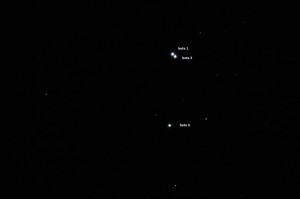by Dave Blane
β Tucanae (0 31 32.56 -62 57 29.1)
The two brightest components of β Tucanae are currently about 27 arc seconds apart and in the WDS catalogue this pair has the designation LCL 119. At magnitudes 4.33 and 4.53 they form one of the most splendid double stars visible to binoculars or telescopes in the sky.
Although the corresponding Hipparcos parallaxes are 23.95 and 18.35 mas the formal error on the latter star is 3.34 mas so it might be argued that the stars are a physical system.
Certainly the proper motions are similar and large enough, that taken in conjunction with the small change in relative position since 1826, the two stars are moving through space together. This proper motion is shared by a third star of mag 5.1 (β3) some 5 arc minutes away so that to the small telescope user, this is a beautiful triple system.
In 2009 the writer measured the position angle and separation to be 169 deg and 26.7 arcsec.
But, bring a powerful telescope, such as the 26.5-inch refractor at the observatory in Johannesburg to bear on the group, as W. H. van den Bos did in 1925, and further stars appear. Robert Innes, using the same telescope which now bears his name, had already found that β2 was a very close and unequal double star which turns out to be a binary of period 44.7 years. The current separation is 0.40 arc second and closing. van den Bos added companions to both β1 and β3, now B 7 and B 8 in the WDS. The companion of B 7, some 10 magnitudes fainter than the primary at a distance of only 2 arc seconds must be a formidably difficult star to see. B 8 is pair of 6th magnitude stars separated by little more than 0.1 arc second. Little is known about this latter pair – it has not been measured since 1964. The pair may be found 10 deg north of the famous globular cluster, 47 Tucanae, and is easy to spot with binoculars or a small telescope.

Image of the beta Tucanae system by Kos Coronaios
(8in f10 15 secs)

